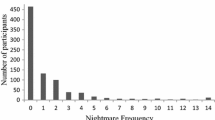Abstract
Factors affecting or inducing nightmares have been investigated repeatedly. However, little research is carried out on the behavioral consequences of nightmares. The present study thus served to investigate behavioral effects of nightmares in correlation to personality variables. 41 non-clinical participants, who suffer from about 2 nightmares per month recorded their dreams and nightmares over a 4-week period. A nightmare was defined as a dream that frightens the dreamer and could be recalled in detail on awakening. Anxiety and mood were monitored every morning. All nightmares and their behavioral consequences were noted on a questionnaire. Personality traits and life events were assessed at the beginning of the investigation. 100 nightmares were reported by the subjects over the 4-week period (range: 0–8). Following a nightmare, the subjects were significantly more anxious and were of a less stable mental condition compared to nights without nightmares. Additionally, nightmares induced physical complaints. This was considered to be an indicator that something was wrong in their lives and induced them to solve personal problems. The behavioral effects were most pronounced in subjects scoring high on neuroticism and on the number of physical complaints and low on achievement orientation and openness. The results suggest that sufferers of nightmares intend to change their lives, especially those with a neurotic-like personality.
Similar content being viewed by others
References
American Sleep Disorders Association (1990). The international classification of sleep disorders.Lawrence, KS: Allen Press, Inc.
Belicki, K. (1985). The assessment and prevalence of nightmare distress. SleepResearch, 14, 145.
Belicki, D. (1987). The relationship of nightmares to psychopathology, stress, and reactivity tostress. Association for the Study of Dreams Newsletter, 4, 10.
Belicki, K. (1992). Nightmare frequency versusnightmare suffering with implications for treatment and research. Dreaming, 2, 143–148.
Belicki, K. & Belicki, D.(1986). Predispositions for nightmares. A study of hypnotic ability, vividness of imagery, and absorption. Journal of Clinical Psychology, 42, 714–718.
Berquier, A. & Ashton, R. (1992). Characteristics of the frequent nightmare sufferer.Journal of Abnormal Psychology, 101, 246–250.
Bixler, E., Kales, A., Soldatos, C., Kales, J. & Healey, S. (1979).Prevalence of sleep disorders in the Los Angeles metropolitan area. American Journal of Psychiatry, 136, 1257–1262.
Bliwise, D. L. (1996). Historical change in the report of daytime fatigue. Sleep, 19, 462–464.
Celluci, A. J. & Lawrence, P. S. (1978). Individual differences in self-reported sleep variable correlations among nightmare sufferers. Journal of Clinical Psychology, 34, 721–725.
Cernovsky, Z. Z. (1984). Life stress measures andreported frequency of sleep disorders. Perceptual and Motor Skills, 58, 39–49.
Cuddy, M. A. & Belicki, K. (1992).Nightmare frequency and related sleep disturbance as indicators of a history of sexual abuse. Dreaming, 2, 15–22.
Fahrenberg J., Hampel, R. & Selg, H. (1989). Das Freiburger Persönlichkeitsinventar (FPI).Göttingen: Hogrefe.
Feldman, M. J. & Hersen, M. (1967). Attitudes towards death in nightmare subjects.Journal of Abnormal Psychology, 72, 421–425.
Halliday, G. (1987). Direct psychological therapies for nightmares:A review. Clinical Psychological Review, 7, 501–523.
Hartmann, E. (1984). The nightmare: The psychology andbiology of terrifying dreams. New York: Basic Books.
Hartmann, E., Russ, D., van der Kolk, B., Falke, R. & Oldfield, M. (1981). A preliminary study of the personality of nightmare sufferers. Relationship to schizophrenia and creativity? American Journal of Psychiatry, 138, 794–797.
Hartmann, E., Russ, D., Oldfield, M., Sivan, I. & Cooper, S.(1987). Who has nightmares? Archives of General Psychiatry, 44, 49–56.
Haynes, S. & Mooney, D. (1975).Nightmares: Etiological, theoretical, and behavioral treatment considerations. Psychological Record, 25, 225–236.
Hearne, K. M. T. (1991). A questionnaire and personality study of nightmare sufferers. Journal of Mental Imagery, 15, 55–64.
Hersen, M. (1971). Personality correlates on nightmare sufferers. Journal of Nervous and Mental Disease,153, 27–31.
Holmes, T. & Rahe, R. (1967). The social readjustment rating scale. Journal of PsychosomaticResearch, 11, 213–218.
Janke, W., Debus, G., Erdmann, G. & Hüppe, M. (1997). Die BSKE.(unpublished).
Kales, A., Kales, J. D., Soldatos, C. R., Caldwell, A. B., Charney, D. S. & Martin, E. D. (1980).Nightmares: Clinical characteristics and personality patterns. American Journal of Psychiatry, 137, 1197–1201.
Klink, M. & Quan, S. F. (1987). Prevalence of reported sleep disturbances in a general adult population and their relationshipto obstructive airways diseases. Chest, 91, 540–546.
Krakow, B., Kellner, R., Neidhardt, J., Pathak, D. & Lambert, L. (1993). Imagery rehearsal treatment of chronic nightmares: With a thirty month follow-up. Journal of Behavior Therapy and Experimental Psychiatry, 24, 325–330.
Krakow, B., Tandberg, D., Scriggins, L. & Barey, M. (1995).Acontrolled comparison of self-rated sleep complaints in acute and chronic nightmare sufferers. Journal of Nervous and Mental Disease, 183, 623–627.
Lang, R. J. & O'Connor, K. P. (1984). Personality, dream content and dream coping style.Personality and Individual Differences, 5, 211–219.
Laux, L., Glanzmann, P., Schaffner, P. & Spielberger, C. D.(1981). Das State-Trait-Angstinventar. Weinheim: Beltz.
Starker, S. (1974). Daydreaming styles and nocturnaldreaming. Journal of Abnormal Psychology, 83, 52–55.
Starker, S. (1984). Daydreams, nightmares and insomnia:The relation of waking fantasy to sleep disturbances. Imagination, Cognition and Personality, 4, 237–248.
Starker, S. & Hasenfeld, R. (1976). Daydream styles and sleep disturbance. Journal of Nervous and Mental Disease, 163, 391–400.
Wood, J. & Bootzin, R. R. (1990). The prevalence of nightmares and their independence from anxiety. Journal ofAbnormal Psychology, 99, 64–68.
Author information
Authors and Affiliations
Rights and permissions
About this article
Cite this article
Köthe, M., Pietrowsky, R. Behavioral Effects of Nightmares and Their Correlations to Personality Patterns. Dreaming 11, 43–52 (2001). https://doi.org/10.1023/A:1009468517557
Issue Date:
DOI: https://doi.org/10.1023/A:1009468517557




